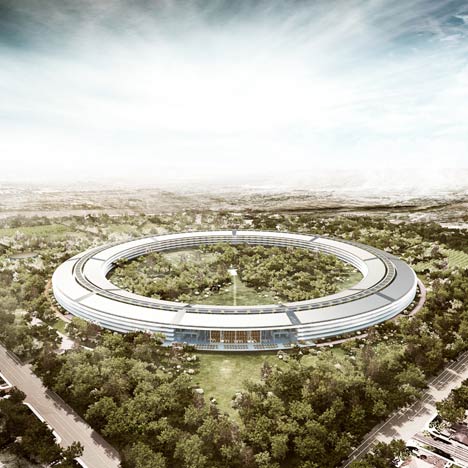Web 1.0 firms prided themselves not just on the informality of their office space but the austerity. Giant tech firms aren’t just lavish now, but their campuses possess identities as pronounced as those of nation-states. Some day (and relatively soon) they will all be gone, but presently they are gleaming cities on a hill. What do the offices of Google and Twitter and Apple tell us about our more collective future? From Kate Losse’s essay “Tech Aesthetics” at Aeon:
“The trend towards office design as an expression of employee taste began after the dotcom crash, when tech companies auctioned off all of their Aeron chairs and ping pong tables, which had come to symbolise tech-office playfulness. As a result, tech offices of the early 2000s tended towards a more sober utility, meant to reassure investors of their restraint.
It took a new generation of companies to renew the playful tech aesthetic. In 2004, Mark Zuckerberg moved Facebook from his dorm room at Harvard University cross-country to its headquarters in Silicon Valley. The company’s first office on Emerson Avenue in Palo Alto recreated Zuckerberg’s dorm room in its design aesthetic, with a video game room replete with ratty couch and rattier blankets. Meanwhile Google’s headquarters in nearby Mountain View adopted a playful, more elementary-school feel with primary colours, exercise balls, and oversized robot sculptures. By 2007, the Day-Glo look – what one could call the ‘orange period’ – had taken over tech, transforming conferences, T‑shirts, and offices into seas of bright orange, yellow and lime green.
The economic crash of 2008 ushered in a new, almost military sobriety, best represented by Facebook’s renovation of an old Hewlett-Packard building in the Stanford Research Park in Palo Alto complete with cavernous, sterile rooms and cement floors. As the economy recovered over the next several years, a new idiosyncratic kind of luxury began to flourish, evident in the appearance of custom pieces, hand-hewn wooden trimmings, and the increasingly eclectic fixtures that mark today’s tech offices. This latest trend can be read as an attempt to disguise work – with trimmings that suggest personality in place of the smooth, ordered humming of a corporate workforce.
This is why the walls in Facebook’s latest headquarters in Menlo Park are covered in graffiti: it makes an office sited on suburban marshland seem like a buzzy urban street. Reassuringly for its well-off workers, however, it’s still a high-end kind of street where the graffiti is done by artists on commission rather than by some masked figure spray‑painting without permission.
What connects Facebook’s incongruous graffiti and Twitter’s incongruous log cabins is their expense. Both represent a complete renovation of the space, making graffiti and log cabins (not in themselves luxurious) seem like high-end amenities.”
Tags: Kate Losse

